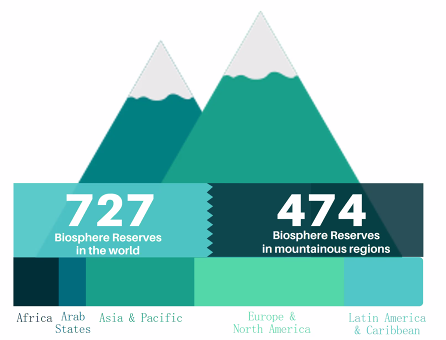 The first meeting of the World Network for Mountain Biosphere Reserves (WNMBR) took place on 12 May 2022 and was the opportunity to launch the network’s activities. The WNMBR was officially launched in December 2021, with the support of the UNESCO Man and the Biosphere Programme and the Mountain Research Initiative.
The first meeting of the World Network for Mountain Biosphere Reserves (WNMBR) took place on 12 May 2022 and was the opportunity to launch the network’s activities. The WNMBR was officially launched in December 2021, with the support of the UNESCO Man and the Biosphere Programme and the Mountain Research Initiative.
Mountain areas are rich biodiversity hotspots, play a key role in providing ecosystem services, host 15% of the global population and are especially threatened by climate change. On the 727 biosphere reserves in the world, 474 are located in mountain areas (65%). The World Network for Mountain Biosphere Reserves aims to bring them together to better address their specific challenges.

Activities of the World Network for Mountain Biosphere Reserves
The World Network for Mountain Biosphere Reserve aims at:
- Promoting the exchanges of experiences between biosphere reserves’ managers in order to improve their management and their contribution to the UN Sustainable Development Goals. In particular, attention will be paid to issues related to climate change, biodiversity conservation and reduction or prevention of natural hazards.
- Establishing strategic partnerships with other institutional entities to increase their outreach and the awareness on mountain biosphere reserves.
- Encouraging research for mountain biosphere reserves, and not only about them, to develop new tools for their management.
The WNMBR’s Secretariat will be co-managed by RCEES (Chinese Academy of Sciences) and the Spanish Mountain Biosphere Reserve of Valles de Omaña y Luna. The Secretariat will lead the network’s activities and provide technical assistance to mountain biosphere reserves.
Until the end of 2022, the Secretariat will work on consolidating the network. Tools for internal communication will be set up to encourage the exchange of knowledge between mountain biosphere reserves. External communication will also be encouraged to increase the awareness among other institutions and public on the importance to preserve mountain biosphere reserves.
Working groups should be created by the end of the year to encourage collaboration between territories facing similar challenges. Many topics were mentioned by experts as relevant for working groups, such as biodiversity conservation, climate change, indigenous knowledge and cultural values, training and natural education, sustainable resources management and demography among others.
In the next few months, the World Network for Mountain Biosphere Reserve should organise several events in the framework of the International Year of Sustainable Mountain Development, of the International Biosphere Reserves Day on 3 November and of the International Mountain Day on 11 December. In Spring 2023, the WNMBR also plans to organise the first congress of Mountain Biosphere Reserves.
What is a Mountain Biosphere Reserve and how to join the network?
 Officially, Biosphere Reserves comprising territories at 1000 metres above sea level can be considered as Mountain Biosphere Reserves. Yet, the network intends to be inclusive and to let entities decide by themselves if they consider to be mountainous or not. Some biosphere reserves located on mountainous islands might for instance identify more to the insular dimension than to the mountainous one.
Officially, Biosphere Reserves comprising territories at 1000 metres above sea level can be considered as Mountain Biosphere Reserves. Yet, the network intends to be inclusive and to let entities decide by themselves if they consider to be mountainous or not. Some biosphere reserves located on mountainous islands might for instance identify more to the insular dimension than to the mountainous one.
Mountain Biosphere Reserves are invited to join the network. The network’s website is still under construction but should be available during the summer 2022 at: www.mountainbiosphere.org
In 2022, Euromontana will be organising its XII European Mountain Convention on Smart Mountains in the Natural Park & Biosphere Reserve of Sila, Italy, on 25-26-27 October 2022.
For further information, you can also check the event report from Euromontana’s 2021 webinar “Smart mountains: how can biosphere reserves contribute to the Green Deal?”
13 May 2022









